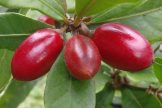
These long lived deciduous or evergreen shrubs can be grown purely for their ornamental value. With their lovely pink brushed white bell shaped flowers and brilliant yellow, orange and red autumn foliage on a 1 to 2.4m high thornless shrub, they add value to any garden.
Blueberries are an ideal fruiting plant for the home garden, related to azaleas and rhododendrons, they require similar (but more acidic) growing conditions: an acidic (pH of 4.5 – 5.5), well drained soil, rich in organic matter, in a sunny position (they can take limited amounts of shade and in very hot regions may benefit from protection from the full blast of the hot afternoon sun). Their roots are shallow and fibrous and should not be allowed to dry out. Mulch is ideal around blueberries because it protects the roots and controls weeds and the plants thrive on the organic matter provided and the consequent soil micro-organisms.
Do not over fertilise your blueberries, additional compost and manure (not chook manure) through the growing season is sufficient. The liquid seaweed or fish emulsions are also beneficial. Little and often is best with fertilising blueberries.
Blueberries require 750+ chill hours, Melbourne commonly gets 650 chill hours (outer suburbs get more) – so a mild winter may see poor fruit set. If in a warm spot, look for low chill blueberries like Sunshine Blue.
Bees are essential for a good fruit set, so consider companion planting. For good fruit ripening blueberries need at least half a days sun and are best protected from strong winds, do not let the soil dry out. The average mature bush should produce around 5kg of berries. The fruit ripens in clusters, but unevenly. They ripen over 5 to 6 weeks and you need to select the largest berries in each cluster to pick. Repeat this process each week. You may need to protect the berries from birds with netting.
Pruning
For the deciduous blueberries: In the first two years remove weak and spindly growth in winter, and remove the flowers in spring to avoid fruit set. At this stage you want the plant to put its energy into its overall root and branch structure, not fruiting.
From the third year on prune each winter, keeping only the strong canes and laterals. Remove the cross growing twiggy growth and any low growth around the base – leaving lonely upright canes from the base. Select for bright coloured wood with long (at least 3 inch) laterals. Remove blotchy colored short growth. If 1/3 to 1/2 of the wood has not been removed by the above steps, thin out the fruiting laterals and small branches until this balance has been obtained. Try to plant your blueberries a minimum of 1m apart.
Growing in Pots
Use a premium azalea/camellia potting mix for your blueberries. The pH will be appropriate and you need the superior drainage, water holding capacity and fertiliser provided by a premium potting mix. Economy potting mix will not do for blueberries. Their dense fine roots need an open structured potting mix, and without this the plant will not survive more than a few years. In warmer months mulch the top of the pots and after 3 months add a slow release fertiliser (repeat every 3 months). When the fruit is setting and developing, a boost every few weeks with a liquid fertiliser (must be a fertiliser, not a tonic like Seasol) will help. Water regularly, but do not over-water, check soil moisture with your finger – damp but not wet. Try to water the soil rather than the foliage, this helps discourage fungal problems. Keep an eye out for rust, if you even suspect rust use a copper based fungal spray – don’t wait. The dwarf evergreen varieties are perfect for pot culture.





